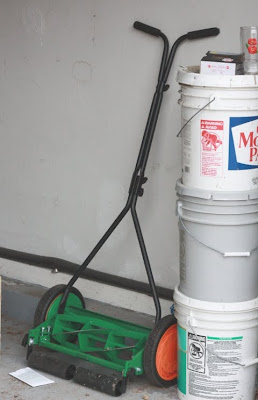 This article was originally published in my local paper, the Franklin Country Gazette. That's me there, the "Garden Geek".New England Gardens are Blooming
This article was originally published in my local paper, the Franklin Country Gazette. That's me there, the "Garden Geek".New England Gardens are BloomingNew England’s gardens are in bloom. Crocus and forsythia have led the way, followed by daffodils and tulips. Summer will bring lilacs, daylilies, and periwinkle. Because these are the flowers we see blooming across New England’s yards, it is easy to assume they are natives of New England. All of these plants, however, originate in Europe or Asia.
Some common garden flowers are natives of New England: rhododendron, phlox, and black-eyed Susan. Some species of azalea are native, as are some species of dogwood.
Commercial nurseries, and big box stores in particular, traditionally favor exotic plants over natives. This is a relic of decades past, when plants from abroad were a status symbol for the wealthy. The history of the tulip, for example, is particularly interesting. In 1637 the Dutch government had to crack down on a speculative tulip trade so rampant that a single tulip could sell for as much as a house.
Nurseries, for sound business reasons, like to sell plants that are easy to propagate and “pest resistant”. Landscaping companies use these cheap, tough McPlants as a green band-aid in the empty spaces around new buildings. This is why every parking lot in New England is surrounded by burning bush, forsythia, and daylilies.
Because nurseries have focused so heavily on exotics and on a few particularly showy natives, a wide selection of native flowers have gone unrecognized for their garden potential. If you saw it, would you recognize serviceberry, virgin’s bower, trillium, steeplebush, summersweet, or wild senna? Did you know that there are native orchids, called lady’s slipper? Have you ever seen the state flower of Massachusetts, the Mayflower?
If you have seen Mayflower or lady’s slipper, consider yourself lucky. Mayflower has been on the endangered species list since 1925. Lady’s slippers are quite rare, too, because people dig them up from the woods to take home, which usually kills them.
So much of New England has been converted to suburban lots, and so little remains undeveloped, that those plants not used in the garden trade are in rapid decline. And with them, also in decline, are the insect species that require those plants as food and habitat. Most bird species need insects to feed to their young, but the gardens of our yards and strip-malls are chock full of insect-resistant plants sprouting from insecticide-sprayed lawns and cedar-bark mulch hell strips. Forsythia and burning bush and daylilies may be lovely, but to our bird populations, they are deserts of starvation.
Author and entomologist Douglas Tallamy makes exactly this point in his book “Bringing Nature Home”. “We humans have disrupted natural habitats in so many ways and so many places,” he writes, “that the future of our nation’s biodiversity is dim unless we start to share the places in which we live. . . with the plants and animals that evolved there.” He posits that our suburban lots have the potential to be both glorious flower displays and havens for wildlife, if we just go a little out of our way to locate and garden with native plants. His book includes detailed information on native trees, as well as native flowers and grasses, and native butterflies and the plants that host them.
Thankfully, local nurseries are responding to a budding interest in natives among gardeners and landscape professionals. Be sure to let the nursery staff know that you are looking for native plants. Don’t be fooled by packets of “wildflower” seed, because “wild” does not necessarily mean “native”. Read the labels on what you buy, and if in doubt, consult the USDA’s Natural Resources Conservation Service Plants Database at plants.usda.gov , where you can view the native status and range of almost any plant growing in the US.
Even if they have caught the enthusiasm for native plants, local nurseries are still likely to be limited to the most popular picks. But this is where the internet comes to the rescue, with online native plant sources such as
Prairie Moon Nursery and
Easy Wild Flowers.
Here in Massachusetts we also happen to be near the New England Mecca for native plant lovers: the Garden in the Woods, in North Framingham. Garden in the Woods, part of the New England Wild Flower Society, is a wooded parkland that has been heavily and exclusively gardened with native plants. The scenic trails meander through every possible New England garden setting, from deep shade to desert to meadow to wetland. Garden in the Woods offers classes, consulting services, and extensive information at
newfs.org. And, of course, Garden in the Woods has a nursery where many varieties of hard-to-find native plants can be purchased.
This spring, make yours a truly New England garden by planting Massachusetts’s state flower.




















































